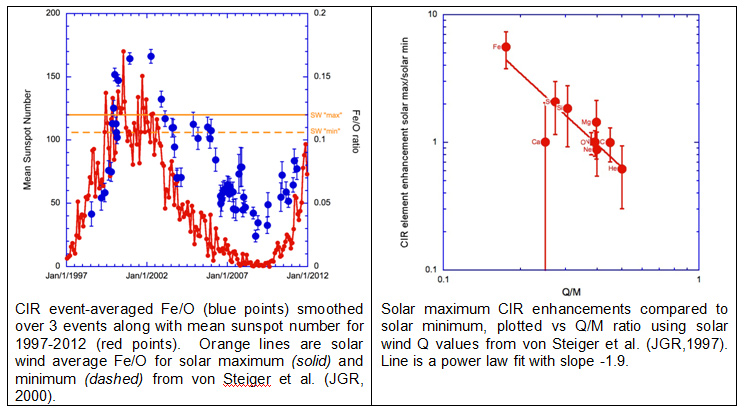
Corotating Interaction Regions (CIRs) arise from the interaction of fast- and
slow-solar wind streams, and can energize particles to a few MeV/nucleon and
sometimes even higher energies. The heavy ion composition of CIRs has long
been known to generally resemble the solar wind; however, observations on ACE
and Ulysses showed abundances of rare components He+
and 3He far in excess of
the solar wind values. These rare tracers provide evidence that suprathermal
tail particles are a source material since these rare ions are found in the
suprathermal population as pick-up-ions and solar flare remnants. This leaves
open the question of whether the dominant heavy ion seed population is from
the bulk solar wind or suprathermal ion pool.
To investigate this we extended our previous ACE/ULEIS survey of CIR heavy ion
abundances and spectra to cover the 1998-2011 period including the onset of
the new solar cycle. We find that the solar minimum CIR intensities and
spectral forms are similar to those in active periods, indicating that the
basic acceleration mechanism does not vary with solar activity for energies
below a few MeV/nuc. However, the heavy ion abundances show a clear
correlation with sunspot number (Figure, left panel), where heavy ions are
more enhanced during active periods. Over the mass range He-Fe, the
enhancement is organized by a power law in Q/M with exponent -1.9, with Fe/O
varying by a factor of ~6, as shown (Figure, right panel). These observations
are evidence that in addition to rare
He+
and 3He
the CIR major heavy ion
species are accelerated out of the suprathermal ion pool, not the bulk solar
wind. This is consistent with a scenario where heated solar wind enters the
suprathermal ion pool where it mixes with other constituents such as rare
tracer ions or remnant solar energetic particles, etc., and this forms the
seed population for further acceleration in CIRs. The mechanism producing the
suprathermals apparently has a solar cycle dependence which is responsible for
the abundance properties we have observed. For additional details, see Mason
et al., ApJ (Letters), 748, L31, 2012.
This item was contributed by
Glenn Mason, Johns Hopkins University Applied Physics Laboratory,
Mihir Desai, Southwest Research Institute,
and Gang Li, Univ. Alabama in Huntsville.
Address questions and comments to
ACE News Archives
Subscribe to ACE News
ACE Homepage
Last modified 19 Mar 2012.